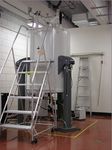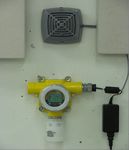Department of Chemistry NMR Laboratory General Safety Information - Department of Chemistry, University of Alberta May 2012
←
→
Page content transcription
If your browser does not render page correctly, please read the page content below
Department of Chemistry NMR Laboratory General Safety Information
Department of Chemistry, University of Alberta
May 2012The use of the NMR instrumentation within the Department of Chemistry is a privilege for users, not a right. It
is of utmost importance that each user understands all of the safety hazards and complies with correct standard
operating procedures. Failure to do so can result in instrument damage and more seriously, personal injury and
even death. Due to the high cost of the NMR equipment and related repairs all users must inform the NMR
personnel of all issues with the equipment and not attempt any repairs themselves. Failure to do so will
result in the suspension of privileges. The NMR staff can be found in room WB-13 (phone: 22573).
A. General Guidelines and Procedures
1. The Magnetic Field
The NMR magnet needs no external power source nor can it be readily or easily turned off. Be aware that:
The magnet is ALWAYS ON!
To obtain the NMR phenomenon large magnetic fields are needed. Magnetic field strengths of 7.0 Tesla to 16.5
Tesla (compare with the Earth's magnetic field of ~1x10-4 T; 1 Tesla = 10000 Gauss) can be found within the
Department of Chemistry. There are large attractive forces associated with these magnets and in fact, every
magnet has a stray magnetic field that extends out past the physical structure of the magnet. These attractive
forces will be exerted on equipment and people brought into proximity of the magnet. The closer to the magnet
one goes the larger the attractive force. The larger the mass of the equipment, the larger the attractive force. The
safety zone or 5 G (5 x10-4 T) line is indicated by signs, plastic chains, and/or marks on the floor around each
NMR magnet.
The 5 G line.
Fig. 1 700 MHz NMR spectrometer. The 5 G line is indicated by
the painted yellow line on the floor.Inside the 5 G line, near the magnet:
• Damage, injury and even death can occur to users who have medical implants and/or pacemakers.
• Damage can occur to personal items such as certain types of watches, most bank cards, magnetic media,
etc.
• Small ferrous items such as tools (i.e. wrenches, screw drivers, tweezers) can be drawn quickly and
unexpectedly to the magnet and can even become a projectile, potentially causing personal injury and
equipment damage.
• Large equipment such as gas cylinders can be particularly dangerous due to their mass. These items can
cause crushing amputation injuries and even death.
• Objects drawn to the magnet can become lodged inside the central bore of the magnet or remain on the
side of the magnet. These items can be difficult to impossible to remove and will impede the function of
the spectrometer.
• Objects drawn quickly to the magnet can puncture the structure of the magnet or distort the magnet’s
internal structure of the magnet and can cause the magnet to quench.
The spectrometer host computer is situated outside the 5 G line. It is recommended to the end user to remove all
metallic objects and valuables (i.e. coins, cell phones, bank cards, watches, etc.) from their person and leave
them beside the spectrometer host computer before approaching the magnet.
Persons with medical implants and devices are recommended to stay outside of the labs that house the NMR
spectrometers. Warning signs are posted at the entrance of all NMR labs, shown below.
Fig. 2. The warning sign posted outside of every NMR lab.
Gas cylinders and other equipment should be brought into and around the NMR magnets only by the authorized
personnel (i.e. the NMR staff).2. Magnet Quench
Superconducting NMR magnets contain a large solenoid or coil made up of several kilometers of
superconducting wire. This coil resides in a bath of liquid helium (up to 260 L for some NMR magnets within
the Department). The wire contains and passes electric current without resistance only when cryogenically
cooled to 4 K by liquid helium; the current contained in the coil produces the magnetic field. Should the
solenoid or cryogenic system fail, the wire becomes resistive and generates heat as the electric current stored in
the solenoid is lost; a situation referred to as a magnet quench. During a magnet quench, there will be a sudden,
large, rapid, and noisy expulsion of helium gas from the magnet (Fig. 3) as liquid helium vaporizes into a gas
(1L of helium turns in to ~800L of gas). Magnet quenches are very rare events but if a quench occurs:
• There will be a sudden and loud release of helium gas from the top of the magnet. Clouds of water vapor
will appear as the air around the magnet cools. Frost will appear on top of the magnet. See Fig. 3.
• The rapidly expanding gas emanating from the magnet can displace the air in the room and there is a
possibility of asphyxiation in a confined space.
Fig. 3. April 10, 2003, 200 MHz NMR magnet quench during decommissioning of the instrument.
What to do in case of a quench:
• DO leave the room immediately.
• DO notify all people in the vicinity to evacuate.
• DO warn others not to enter the room.
• DO notify the NMR personnel immediately.Due to the number of NMR magnets and/or room size, rooms W1-19, SB-3E, and EB-44 have oxygen sensors
with audible and visual alarms, shown below, Fig. 4. These alarms will sound (potentially due to a magnet
quench) when oxygen levels have been reduced to unsafe levels. If these alarms sound DO leave the room
immediately and/or DO NOT enter the room.
Fig. 4c: Oxygen sensor located in EB-44.
Fig. 4a: Oxygen sensor and audible alarm that can be
found in SB-3E and W1-19.
Fig. 4b: Visual oxygen alarm found at the entrance to
W1-19 and SB-3E. Fig. 4d: Audible and visible oxygen alarms found at
the entrance to EB-44.3. NMR tubes and samples
NMR tubes are thin-walled glass tubes and are fragile. Although they are used daily personal injury can (and
has) resulted when fixing the cap to the tube and inserting the tube into the spinner or turbine.
When handling your NMR tube we recommend:
• DO use your fingers instead your palm when inserting an NMR tube into a spinner and/or depth gauge.
• DO NOT use excessive force to insert your NMR into the spinner, very little effort is required. Examine
your NMR tube and spinner for foreign material if force seems necessary and seek assistance from the
NMR staff.
• DO NOT use excessive force to fix a cap to a NMR tube.
• DO dispose of NMR tubes that are chipped, cracked, scratched, or damaged in any manner. Damaged
NMR tubes greatly increase the likelihood of personal injury and equipment damage.
• DO NOT dry your NMR tubes in an oven. NMR tubes are precision pieces of glassware; the heat of an
oven can distort the shape of the NMR tube. Use of oven dried NMR tubes may damage the
spectrometer.
• DO remember to TURN ON (press the eject button) the lift air before inserting your sample in the
magnet. Neglecting to do so can break your sample and damage the instrument.
Broken samples are inevitable however care must be taken by the end user to ensure the health and safety of the
other users of the NMR facility. Many samples are unknown entities that can be harmful. The items at the
spectrometer host computer are communal items that everyone uses, the depth gauge, spinner, mouse, keyboard
and desk. Some of these items do need to be disassembled to be cleaned properly. If a sample breaks, the end
user is required to:
• Inform the NMR staff and ask for assistance.
• Clean up all glass and place in a labeled glass waste containers.
• Make sure all equipment is free of solvent/sample by cleaning up all chemicals.
• If a sample is broken within the magnet, the NMR staff must be informed immediately!
4. Miscellaneous
NMR magnets tend to be quite large. Steps and/or ladders are provided to facilitate putting your sample in the
magnet. Take caution to avoid losing your balance and falling.
Due to the multiuser environment and high throughput of the NMR facility within the Department of Chemistry
it is not recommended to eat in the lab. Beverages are permitted.You can also read

























































